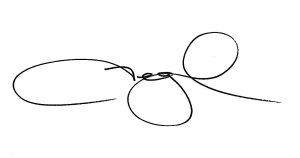CCRF Christmas Appeal 2022
December 2022
Dear Foundation Supporter,
With Christmas almost upon us, many families will come together to celebrate in their own ways. I want to share our family’s story, reminding me of how lucky I am to celebrate Christmas with my two beautiful children.
My family owes a great debt to the advancements made through childhood cancer research, especially from this Foundation that has funded research for over 42 years. I honestly believe my son would not be here today without that funding.
Let’s start at the beginning.
My son Logan was diagnosed with cancer when he was only two-and-a-half years old. Logan’s diagnosis was a massive shock for my family, and it has filled me with a desire to help make a difference for other families who are now going through it.

Logan was a typical energetic little boy, but he had been hit hard with what we thought to be the flu. He had high temperatures daily, with his energy levels going down more and more each day.
My family was enjoying a fun day out on a friend’s boat, skiing up the Swan River. On this particular day, I couldn’t help but notice how pale Logan was, so I took him to the GP the following day. I assumed they would just prescribe antibiotics for a chest infection. I had no idea what was about to hit us.
We visited the GP at 10 am, and after a quick examination, not only did she seem very concerned with his lack of colour, but she noticed petechiae bruising, which I thought was just a viral rash. We were told to get blood tests immediately.

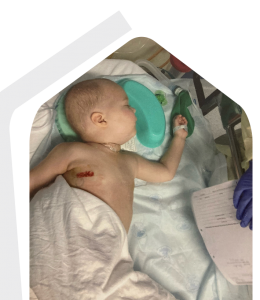
Logan had never had a blood test before, and I was under the impression the nurse there had never taken blood from a child. It was incredibly traumatic. Three unsuccessful attempts to draw blood took two adults to hold Logan down. I refused to let them continue and decided to drive to PMH.
The staff and nurses at PMH were amazing. They knew the best way to keep Logan calm and secure. After our hectic morning and the long drive home, we decided to take an afternoon nap. Feeling refreshed, we woke and started cooking dinner, only to get a call from the hospital saying that there was a problem with Logan’s blood test.
We were told to come back right away, but not to rush – to finish dinner and pack a bag just in case we had to stay the night.

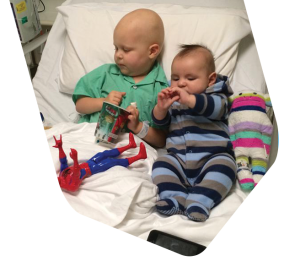
The nurse explained that we had to wait for the doctor to return to the hospital after going home for the day. More alarm bells went off. What could possibly be that important that the doctor must come in after-hours specifically for us?
We were greeted by the lovely Doctor Angela Alessandri, who started to talk at length about how white and red blood cells work. I was growing impatient as it was now late and way past Logan’s bedtime. Doctor Alessandri’s lanyard caught my eye, with one word standing out. Oncology.
Shocked and in disbelief, I blurted out while she was mid-sentence, “he has cancer, doesn’t he?” After a pause that felt like an eternity, she quietly and calmly said, “yes, we believe he does. But we need to work out exactly what type, which is why we need more tests done as soon as possible.” She went on to tell me that Logan needed an immediate blood transfusion, as well as platelets.
Unable to find the words to speak and feeling physically ill, I had to rush to the bathroom. I was heavily pregnant with our second child at the time, and the thought that I would lose a child while bringing a new baby home was more than I could bear.


That night, Logan received a blood transfusion and platelets with hourly observation checks from the nurses. With all the bings and beeps coming from the machines that Logan was hooked up to, I didn’t sleep for more than an hour or two all night. That was the first of seven nights in the hospital while the doctors ran test after test. Logan was diagnosed with acute lymphoblastic leukaemia on 13 November 2013.
When Logan’s treatment plan was presented to us, the medical team asked if we would be interested in participating in a treatment study protocol plan. This would take his initial information and diagnosis and generate a course of treatment. This study aimed to determine what type of drugs and specific doses were effective in treating him.
It was a difficult decision to relinquish control to a random process. As parents, we want to be informed to make any decision that impacts our child’s health, but in this case, we had to put all our trust in the medical system and the professionals.

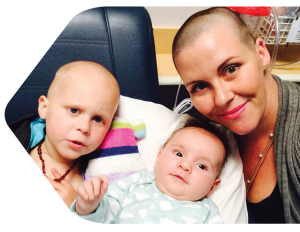
I gave birth to my second son Curtis on 4 January 2014 while Logan was deep in his intensive treatment phase. While most people celebrate the birth of a new child with their family and friends, we had to explain to ours that they were unable to visit us if they even felt the slightest chance of illness. We couldn’t risk putting Logan in danger when he was so immunocompromised. Any illness could have been fatal for him.
Logan lost the ability to walk and even crawl due to the drugs affecting the muscles and nerves in his little legs. Seeing how much the gruelling treatments affected our little boy, who was once so active and energetic, was horrible.
We spent the next nine months mostly isolated from the outside world. We held family and friends to only short visits as our main focus was to keep Logan as healthy as possible to see the end of his treatment.

After three-and-a-half years of treatment, Logan’s fighting spirit saw him kick cancer’s butt, with 17 January 2017 marking the end of his treatment. Finally!
If it wasn’t for the advancements made through childhood cancer research, there’s a chance Logan wouldn’t still be with us today. I’m so thankful to all the amazing scientists doing the ground-breaking work to find better treatments for children with cancer, as well as everyone who helps fund this research.
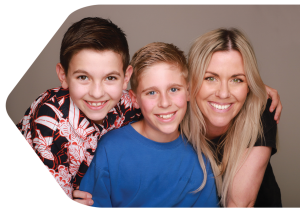
I feel incredibly lucky to have my boy with me this Christmas time, but sadly other families have not been as fortunate. Childhood cancer is the single greatest cause of death from disease in Australian children, and a lot more work needs to be done to ensure fewer lives are cut short.

As you and your family share special moments at your Christmas festivities, spare a thought for the many families who have missed out on this time due to childhood cancer.
If you have already made a gift to help children live the long and fulfilling lives they deserve, we thank you from the bottom of our hearts. If not, will you please consider supporting us today?
As the Foundation receives minimal government funding, we rely on the generosity of people like you to help us continue funding this life-saving research.
Thank you,
Tegan Connolly
P.S. The ground-breaking research that CCRF funds is only possible thanks to our generous supporters. With your help, we believe a future free from the pain of childhood cancer is within reach.


